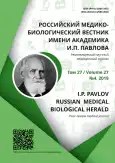健康受试者血液动力学系统对人工调节应激的适应反应
- 作者: Smolyakov Y.N.1, Kuznik B.I.1, Kalashnikova S.A.1, Nolfin N.A.1, Fedorenko E.V.1, Mikhahanov M.M.1
-
隶属关系:
- Chita State Medical Academy
- 期: 卷 27, 编号 4 (2019)
- 页面: 443-450
- 栏目: Original study
- ##submission.dateSubmitted##: 12.04.2019
- ##submission.dateAccepted##: 18.11.2019
- ##submission.datePublished##: 11.01.2020
- URL: https://journals.eco-vector.com/pavlovj/article/view/11697
- DOI: https://doi.org/10.23888/PAVLOVJ2019274443-450
- ID: 11697
如何引用文章
详细
目的:研究人工造成的心理情绪应激对躯体健康的青少年外周微循环血流动力学指标的影响。
材料与方法:本实验参与30名受试者(其中16名男生)。平均年龄为18.2±1.1岁。人工应力是由Stroop effect产生的。通过红细胞的动态光散射来评价微循环血流动力学特性。信号以三个血流动力学指标的形式进行整合:HI(Hemodynamic Indexes)。低频率指数(HI1)由缓慢的层间相互作用决定,高频率区域(HI3)表征层移动的快速过程。HI2占据中间位置(毛细血管前和毛细血管血流)。脉搏分量的心脏间隔变异性采用心率变异性(Heart Rate Variability,HRV)被评定。
结果:本研究表明了在测试阶段内心率(HR)加快,这表明心理压力度很高。在血流动力学中,血流在慢剪切速率方向上重新分布(血管壁血流)。在应力暴露终止后,血流动力学参数降低,恢复到原来的值。表征心率可变性的指标:LF(交感神经成分),HF(迷走神经活动),CVI(非线性副交感神经指数)出现呈上升趋势,而LF/HF的比率保持不变。
结论:因而进行的研究结果我们制定了多因素背景的微循环和植物调节心脏速率的指标,特定于诱导应激的适应性反应。所获得的移位的定量标准可以整合到应激指数中,并在临床中使用。由于mDLS的可移植性,该传感器加上特定的评估标准,可用于监测由压力情况引起的适应性反应,并在临床中做出早期诊断和预后决定,以及用于患者自我监测。
关键词:应力;血流动力学;心率变异性;适应;微循环
全文:
应力的概念包括一组在身体内发生的非特定自适应变化,以响应外部和内部影响(应激因素)。受试者对压力的最明显的反应可以被认为是来自神经的反应,并且心血管系统的复杂测量成为评估生物体适应状态的标准之一[1,2]。对健康受试者所研究的压力的起初(早期)反应的机制提供了一个基础与不同类型的病症患者的类似反应比较,从而为早期诊断和预后决策提供了可能性。
目的是研究人工造成的心理情绪应激对躯体健康的青少年外周微循环血流动力学指标的影响。
材料与方法
本实验涉及30名躯体健康的受试者(16名男生和14名女生)。平均年龄为18.2±1.1岁。本研究根据《世界医学协会赫尔辛基宣言》(World Medical Association Declaration of Helsinki,1964年,2013年)的伦理原则进行;俄罗斯联邦国家标准《优良临床实践》(Good Clinical Practice;GCP)(GOST R 52379-2005)。自愿知情同意是从所有参与研究的受试者获得的。本科学实验报告获得了高等教育的联邦国家教育机构赤塔国立医学院当地伦理委员会的批准(2017年11月1日第86号议定书)。
实验分为三个阶段进行,每个阶段持续5分钟:
T1–休息状态,
T2–调制压力,
T3–休息恢复原来状态。
每个阶段都包括血液动力学参数的测量和心率变异性的评估。应激是由实现斯特鲁普效应(Stroop effect)的颜色测试进行的[3, 4]。本方法旨在评估负责感知颜色和字母形状的皮层区域之间的关联关系的形成。颜色和词义的不匹配会导致感知上的冲突,从而产生压力[5-7]。
MDLS动态光散射传感器(miniaturized Dynamic Light Scattering, Elfi-Tech,Rehovot,Israel)记录从相邻血液层中移动红血细胞反射的光子(剪切速率或横向速度梯度)。传感器位于手掌侧面的手的食指上。信号以三个血流动力学指标的形式进行整合:血液流变学指标(Hemodynamic Indexes,HI)。通过快速傅里叶变换(Fast Fourier Transform,FFT)将信号的频谱分解成与不同层剪切速率的血流动力学源相关的频率分量。 低频率(1-300Hz)指数(HI1)由缓慢的层间相互作用决定,高频率(3000-24000Hz)区域(HI3)表征层移动的快速过程。HI2(300-3000Hz)占据中间位置(毛细血管前和毛细血管血流),HI2占据中间位置(毛细血管前和毛细血管血流)。为了评估快速和慢速过程之间血流再分配的趋势,引入了HI1/HI3比率的指标[8-10]。
用心率变异分析(Heart Rate Variability,HRV)来评估从脉冲成分中分离出来的RR间期的变异性。使用了下列的指标:RR间期标准差(Standard Deviation of NN Intervals,SDNN)是所有RR间期的标准偏差(反映负责可变性的所有长期成分和昼夜节律);LF是低频率范围的功率(0.04-0.15Hz),由于交感神经系统的活动及表征压力反射循环延迟时间;HF是高频范围内的功率(0.16-0.5Hz),与呼吸运动有关,主要是由于迷走神经活动造成的;LF/HF是表示整体迷走交感神经平衡的功率比;心-迷走神经指数(Cardiac Vagal Index,CVI)是一种非线性副交感神经指数;心脏交感指数(Cardiac Sympathetic Index,CSI)是非线性交感指数[11]。
统计分析和可视化用于R语言进行的(http://cran.r-project.org),3.4.4版本[12]。Wilcoxon值来评估阶段(T1,T2,T3)之间的所有指标的配对差异的可靠性[13]。介绍了用于多重比较的Hommel校正[14]。在p<0.05水平上决定假设的统计显著性。表中指标的定量表示以M±SD格式制成的(平均值±标准偏差)。
结果和讨论
在(T2)测试期间,所有受试者都有显着的心率增快,然后(T3)期间时将其完全恢复到原始值(图1)。
血流动力学指数也显示了应激刺激的显着变化(见表1)。在第二个阶段(T2)时,出现HI1指标的明显升高(与血管内的缓慢剪切速率和血管壁过程有关)。在第三个(T3)阶段时,指标恢复到原来的数值(见图2)。我们认为HI1的增加可能是由于血管壁过程的激活,又血管舒张造成的(增加血管直径降低剪切速率)。
这意味着HI1/HI3比率的相互显着对比增加,其表征了层间速度分布的平衡。在T3阶段时,本指数有回归到初始值的趋势,但这一过程尚未得到统计学上的证实。
图1。 心率动态
注:此外,被引入了连接对值的线
表1。躯体健康的年轻受试者在应激刺激下的微循环血流动力学指标
指标 | T1 | T2 | T3 | p1 | p2 | p3 |
心率(HR),次每分钟 | 78,7±11,7 | 90,3±11,2 | 76,9±11,9 | <0,0001 | 0,013 | <0,0001 |
HI1 | 158,0±26,4 | 172,0±25,4 | 163,0±22,5 | 0,007 | 0,070 | 0,015 |
HI2 | 460±166 | 480±154 | 460±153 | 0,61 | 0,98 | 0,68 |
HI3 | 255±109 | 246±103 | 243±98,7 | 0,64 | 0,79 | 0,79 |
HI1/HI3 | 0,676±0,270 | 0,773±0,264 | 0,752±0,322 | 0,011 | 0,096 | 0,67 |
注:血流动力学指数是无量纲的数量。HR–心率。根据Wilcoxon对数据的组间比较统计显著性:p1 – T1 和 T2,p2 – T1 和 T3,p3 – T2 和 T3
图2。血流动力学指数HI1的动力学
注:此外,被引入了连接对值的线
同时观察到总可变性指标的增加(见表2),表征植物神经系统的常见的紧张性。测试后,与呼吸行为相关的高频成分HF及主要由迷走神经活动引起的低频LF均显著升高,表征自主神经系统的交感神经分裂的活性,并反映出发生在压力反射循环中的时间延迟。
众所周知,在应激反应中激活副交感神经系统是保护机体免受副作用的机制[15]。然而,在我们的研究中没有显着频率(LF/HF)分布平衡的变化。最显着的升高表示在CVI的非线性副交感神经指数(图3,表2),而非线性交感指数(CSI)保持不变(表2)。
因此,本研究的结果,一方面,再一次证实了在前面所述的应力状态的调制中的斯特鲁普效应(Stroop effect)的作用[3-6, 16],在我们的本研究中,表现在增快的心脏速率和恢复到原来的值终止后的暴露。
表2。心率可变性和自主神经系统状态的变化
指标 | T1 | T2 | T3 | p1 | p2 | p3 |
SDNN,毫秒 | 68,8±22,5 | 87,2±26,4 | 71,5±24,2 | 0,003 | 0,45 | 0,018 |
LF,ms2 | 1090 ± 628 | 1390 ± 681 | 1080 ± 630 | 0,028 | 0,94 | 0,070 |
HF,ms2 | 732±458 | 1130±713 | 740±460 | 0,021 | 0,93 | 0,045 |
LF/HF | 1,62±0,89 | 1,54±0,77 | 1,49±0,76 | 0,96 | 0,96 | 0,96 |
CSI | 1,73±0,46 | 1,79±0,53 | 1,75±0,53 | 0,84 | 0,84 | 0,84 |
CVI | 4,76±0,31 | 4,96±0,31 | 4,8±0,30 | 0,008 | 0,47 | 0,039 |
注:根据 Wilcoxon对数据的组间比较统计显著性:p1 – T1 和 T2,p2 – T1 和 T3, p3 – T2 和 T3
图3。非线性副交感神经CVI指数的动力学
注:此外,被引入了连接对值的线
另一方面,激光散斑干涉测量得到了层间血流动力学的指标显示,在缓慢的HI1(血管壁)组分中对人工创造的压力状态有可靠的反应,并且在早期的暴露断绝后不完全的恢复。血流动力学调节的植物环节显示副交感神经环节的活性增加。
本研究的独特的性质不仅是通过对应激响应的综合评估直接从层间血流动力学过程在微循环床使用无创激光散斑法的分布确定[17], 而且从植物调节方面通过分析从散斑信号的脉搏分量中分离出的心率可变性的方法。
结论
因而进行的研究结果我们制定了多因素背景的微循环和植物调节心脏速率的指标,特定于诱导应激的适应性反应。
血流动力学的特征是微循环床的横截面(血管直径)的增加,并也可能是血管壁黏连过程的激活。植物性神经调节的特点是保持平衡,同时激活两个环节(交感神经和副交感神经)。
所获得的移位的定量标准可以整合到应激指数中,并在临床中使用。由于mDLS的可移植性,该传感器加上特定的评估标准,可用于监测由压力情况引起的适应性反应,并在临床中做出早期诊断和预后决定,以及用于患者自我监测。
作者简介
Yuri Smolyakov
Chita State Medical Academy
编辑信件的主要联系方式.
Email: smolyakov@rambler.ru
ORCID iD: 0000-0001-7920-7642
SPIN 代码: 7440-6632
Researcher ID: R-5740-2017
PhD, Head of the Department of Medical Physics and Informatics
俄罗斯联邦, Gorkogo str. 39a, 672000, ChitaBoris Kuznik
Chita State Medical Academy
Email: bi_kuznik@mail.ru
ORCID iD: 0000-0002-2502-9411
SPIN 代码: 5807-7229
Researcher ID: D-2743-2018
MD, Professor, Honored Scientist of the Russian Federation, Professor of the Department of Normal Physiology
俄罗斯联邦, Gorkogo str. 39a, 672000, ChitaSvetlana Kalashnikova
Chita State Medical Academy
Email: sak-2020@yandex.ru
ORCID iD: 0000-0001-8360-4624
SPIN 代码: 4030-5496
Senior Lecturer, Department of Medical Physics and Informatics
俄罗斯联邦, Gorkogo str. 39a, 672000, ChitaNikolay Nolfin
Chita State Medical Academy
Email: nol.nikol@mail.ru
ORCID iD: 0000-0003-2570-4293
SPIN 代码: 5376-8731
4th year student
俄罗斯联邦, Gorkogo str. 39a, 672000, ChitaEkaterina Fedorenko
Chita State Medical Academy
Email: fedorenko@mail.ru
ORCID iD: 0000-0003-0600-7708
SPIN 代码: 4711-2143
4th year student
俄罗斯联邦, Gorkogo str. 39a, 672000, Chita, RussiaMankhar Mikhahanov
Chita State Medical Academy
Email: mikhahanov@mail.ru
ORCID iD: 0000-0002-0620-2047
SPIN 代码: 6393-8086
4th year student
俄罗斯联邦, Gorkogo str. 39a, 672000, Chita, Russia参考
- Сидоренко Г.И., Комиссарова С.М. Способ оценки фаз стресса у человека // Физиология человека. 2011. Т. 37, №5. С. 73-76.
- McEwen B.S. Stress, adaptation, and disease: Allostasis and allostatic load // Annals of the New York Academy of Sciences. 1998. Vol. 840, №1. P. 33-44. doi: 10.1111/j.1749-6632.1998.tb09546.x
- Stroop J.R. Studies of Interference in Serial Verbal Reactions // Journal of Experimental Psychology. 1935. Vol. 18, №6. P. 643-661.
- Scarpina F., Tagini S. The Stroop color and word test // Frontiers in Psychology. 2017. №8. P. 557. doi: 10.3389/fpsyg.2017.00557
- Сидоренко Г.И., Фролов А.В., Воробьёв А.П. Психоэмоциональные тесты и перспектива их применения в кардиологии // Кардиология. 2004. Т. 44, №6. С. 59.
- Сысоева Т.А. Теоретический анализ механизмов возникновения эмоционального эффекта Струпа // Психология. Журнал Высшей школы экономики. 2014. Т. 11, №1. С. 49-65.
- Смоляков Ю.Н., Калашникова С.А., Федоренко Е.В., и др. Динамические реакции активности коры головного мозга и микроциркуляции на стимулированный стресс // Забайкальский медицинский вестник. 2017. №2. С. 148-153.
- Fine I., Kaminsky A. Speckle-based measurement of the light scattering by red blood cells in vivo // Dynamics and Fluctuations in Biomedical Photo-nics VIII. 2011. Vol. 7898. P. 78980A. doi:10. 1117/12.881991
- Kuznik B.I., Smolyakov Y.N., Davydov S.O., et al. Impact of Fitness Status on the Optically Measured Hemodynamic Indexes // Journal of Healthcare Engineering. 2018. Vol. 2018. Article ID1674931. doi: 10.1155/2018/1674931
- Ладнич Н.А., Смоляков Ю.Н. Возможные варианты формирования интегральных показателей оценки биомедицинских исследований // Информатика и системы управления. 2007. №S1. С. 16-18.
- Shaffer F., Ginsberg J.P. An Overview of Heart Rate Variability Metrics and Norms // Frontiers in Public Health. 2017. №5. P. 258. doi:10.3389/ fpubh.2017.00258
- R Core Team (2018). R: A language and environment for statistical computing. R Foundation for Statistical Computing. Vienna, Austria. Available at: https://www.R-project.org/. Accessed: 2019 March 23.
- Wilcoxon F. Individual Comparisons by Ranking Methods // Biometrics Bulletin. 1945. Vol. 1, №6. P. 80-83. doi: 10.2307/3001968
- Hommel G. A Stagewise Rejective Multiple Test Procedure Based on a Modified Bonferroni Test // Biometrika. 1988. Vol. 75, №2. P. 383-386. doi:10. 1093/biomet/75.2.383
- Kim H.G., Cheon E.J., Bai D.S., et al. Stress and Heart Rate Variability: A Meta-Analysis and Review of the Literature // Psychiatry Investigation. 2018. Vol. 15, №3. P. 235-245. doi: 10.30773/pi.2017.08.17
- Renaud P., Blondin J.P. The stress of Stroop performance: physiological and emotional responses to color-word interference, task pacing, and pacing speed // International Journal of Psychophysiology. 1997. Vol. 27, №2. С. 87-97. doi: 10.1016/S0167-8760(97)00049-4
- Tuchin V.V., ed. Handbook of Photonics for Biomedical Science. CRC Press; 2010.
补充文件












